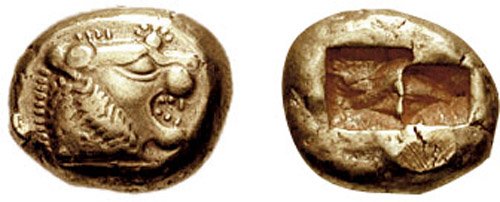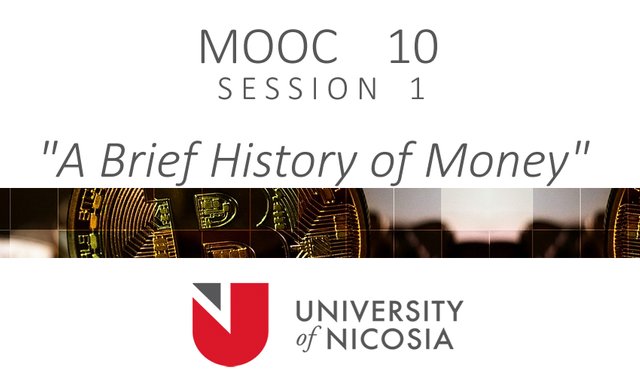Session 1 - A Brief History of Money [MOOC 10 By UNIC]
In continuation to the overview of the Free MOOC offered by the University of Nicosia, this and the upcoming posts will briefly present the sessions that are covered in this introductory MSC course.
The first session is about currency, what it is, what purposes it serves and how it evolved until this day.
Session 1 - A Brief History of Money
Session Objectives
- Understanding the main functions of currency
- Understanding the evolution of monetary history toward fiat currency
- Understanding the main forms of currencies
- Understanding the properties of Bitcoin from a monetary perspective
The Main Functions of Currencies
What is currency and what are its main characteristics?
Money functions as a Medium of Exchange. This practically means that the parties who use the currency, accept it as a payment method. Whenever someone buys goods from a store, money will be accepted as a payment.
A good Medium of Exchange should have specific characteristics.
It should be durable, easy to transfer, easy to divide in smaller parts, interchangeable and difficult to counterfeit.
Currency is a Unit of Account. This means that it is possible to compare the value of different goods using the same unit of measurement.
We can easily compare the cost of one book to the cost of one car and we can also use the cost of one good to quote others (for instance, you can buy 4 t-shirts instead of this dress)
One of the most important charachteristics of currencies is the store of value. Something of value can be stored with the possibility to be retrieved in the future (having some predictability of its future value). Store of value refers to assets, not only currencies.
From Barter to Fiat Currency
Primitive Money
[...] If one asks what is “primitive” about a particular money, one may come away with two answers: the money-stuj-woodpecker scalps, sea shells, goats, dog teeth-is primitive (i.e., different from our own); and the uses to which the money-stuff is sometimes put-mortuary payments, bloodwealth, ridewealth-are primitive (i.e., different from our own).
Primitive money performs some of the functions of our own money, but rarely all; the conditions under which supplies are forthcoming are usually
different; primitive money is used in some ways ours is not; our money is
impersonal and commercial, while primitive money frequently has pedigree
and personality, sacred uses, or moral and emotional connotations. Our governmental authorities control the quantity of money, but rarely is this so primitive economies.
source
In the past, the activity of trading good or services direcly was done through barter agreements, where both parties should have a silmutaneous coincidence of wants.
Coinage
The only form of money was the primitive money until the invention of coinage. The earliest form of coin was invented by the Lydians in Ancient Greece who used gold and silver coins in the early 6th century. China on the other hand was the first to create metal objects as early as 1200 BCE, which evolved into circular coins at approximately 200 BCE.

Rai of Yap
Among the notable forms that primitive money has taken, one of the most curious one is the 'case of the Rai of Yap'
Rai are circular large stones, that were used as currency until the 20th century on the Yap island. Their size could be up to 9000 pounds and since they could not be moved, they simply changed owners. The ownership information was shared in the communities and it is often compared to the blockhain (due to the fact of the 'transaction/history ledger')
While coinage started to dominate Western economies, important issues started to come up. Coin users started to shave coins, action that would lead to value's reducement. In addition to that, the metal pric es would change so much that it was very difficult to make useful comparisons across time
Paper Currency
Paper currency first appeared in China during the 7th century. However it was not widely distributed.
Hundreds of years later, in Amsterdam, the receipts of deposits of coin currency appeared. The first public bank was the Bank of Amsterdam that was founded in 1609 and its task was to bring efficiency to the coinage circulation in Amsterdam (that was a major commercial city)
In the Bank of Amsterdam they would also accept foreign coins and for the exchange to the local 'currency' a small fee would be charged.
The initial operation of Amsterdam's Bank was on a 100% reserve basis (no loans were given to other parties). Later, the Bank started lending money on short-term basis. This practice is known as (fractional reserve banking) and is used to describe the requirement of banks to "hold a reserve equal to a fraction of the bank's liabilities"
The predecessor of all modern Central Banks is considered to be The Bank of England; it was established in 1694 and exists to this day.
The mainstream circulation of banknotes caused various problems, deriving from lack of regulation and laws regarding their value and about who could issue paper money.source In addition to these, the banknotes would easily be reproduced and this would make the public opinion even more skeptical about their use.
The Gold Standard
After the 18th century, most of the World Economies used gold standard, fixing their local currencies into specific prices, converted into gold.
The World War caused countries such as Germany to overprinting Marks; action that caused to extreme hyper-inflation.
The paper Mark traded at 6.7 Marks to the US dollar in 1919. By November 1923, the US dollar was worth 4,210,500,000,000 Marks
In 1944, after the Bretton Woods Conference the countries would adopt fixed exchange rates pegged to the USD, which was pegged to gold. This was called the Quasi-Gold Standard and was abandoned only at 1971.

Fiat Currency
Fiat currency referrs to currency that corresponds to money in a way defined by government regulations. Fiat money does not need to be backed by a physical commodity.
New Forms of Currencies
In the last decades there have been various private currencies issued by centralized issuers (i.e. Disney Coins, Linden Dollars and more) in order to increase money transfers and to facilitate trading between users (often used in community games)
Bitcoin
Bitcoin on the other hand is not issued by a specific authority. Instead, a decentralized group of users is responsible for its creation and operation. It runs fully in digital, there are no psychical coins. Bitcoin's authenticity is ensured by cryptography
The supply of the bitcoins is finite. Only a specific number (21.000.000 will ever be created). There is a predefined set of rules, which the users have agreed to follow.
Is Bitcoin considered to be a good Medium of Exchange?
Bitcoin has very interesting characteristics as a Medium of Exchange. It is highly portable and easily transfered from party to party (confirmation of transaction is approximately 10 minutes). Every bitcoin has the same value and it could be divided in million of units. Bitcoin is durable (not possible to be damaged) and counterfeiting is impossible.
The fungibility of bitcoin is still being discussed as an issue. Even though 1 bitcoin has the same value as any other bitcoin, can be compared and exchanged in terms of value, every digital coin carries its 'history' and all transactions confirmed in the block chain. This, justifiably, creates a conceivable different value between the compared coins.
Is Bitcoin considered to be a good Unit of Account or Store of Value?
Bitcoin has had big fluctuations in its price and most people would argue that Bitcoin is a viable Unit of Account and/or Store of Value.
Bitcoin is often compared with gold, even if gold remains a trusted asset all over the world, while bitcoin is not even close to being considered a universal currency.
A common characteristic between the two, can be considered to be scarcity and there is a widely shared opinion that when all the 21 million Bitcoin will be mined, its value shall find a more steady pace.
Conclusions
Currency is determined as a Medium of Exchange, a Unit of Account and as a Store of Value. There is not a perfect currency in all those functions. Economy is an ever changing sector and at times depends stongly on unexpected factors.
Money has come a long way, since its primitive forms to the fiat money of today and to the digital evolution, bursting in the form of cryptocurrencies.
Bitcoin and other forms of money, private or public are a new form of currency that needs to be explored. In this session we examine the monetary perspective of Bitcoin and other cryptocurrencies.

References & further reading
Lecture Notes - MOOC University of Nicosia / Master of Digital Currencies (2018)
https://www.econlib.org/library/Enc/GoldStandard.html - retrieved 24 July 2018
https://anthrosource.onlinelibrary.wiley.com/doi/pdf/10.1525/aa.1965.67.1.02a00040 - retrieved 24 July 2018
This is a synopsis of what is presented at the 1st Session of the MOOC - Introduction in Digital Currencies.
In the next session we will discuss the Byzantine Generals' Problem and how Bitcoin addresses it
Watch the 1st video session of MOOC10 by Mr Antonis Polemitis
Disclaimer: This post is written by user & student of MOOC 9 @katerinaramm. Approved by @mscdigital prior to its publication

I enjoyed reading the material here. Unlike what I said before the summer, I am heavily overwhelmed and won't be able to follow the lectures. A new term is starting here and I have to take care of too many duties.
I am however glad that you posted a summary here! I can always read :)
Hi @mscdigital!
Your post was upvoted by utopian.io in cooperation with steemstem - supporting knowledge, innovation and technological advancement on the Steem Blockchain.
Contribute to Open Source with utopian.io
Learn how to contribute on our website and join the new open source economy.
Want to chat? Join the Utopian Community on Discord https://discord.gg/h52nFrV
This post has been voted on by the steemstem curation team and voting trail.
There is more to SteemSTEM than just writing posts, check here for some more tips on being a community member. You can also join our discord here to get to know the rest of the community!
How beautifully posted Thanks so much for a great post.